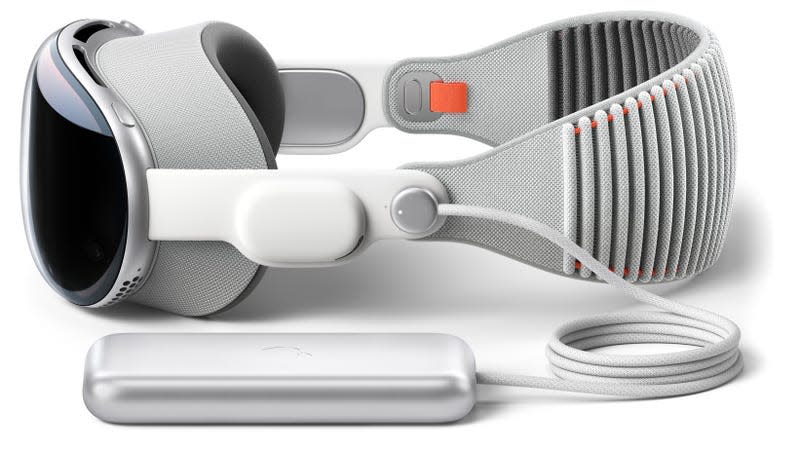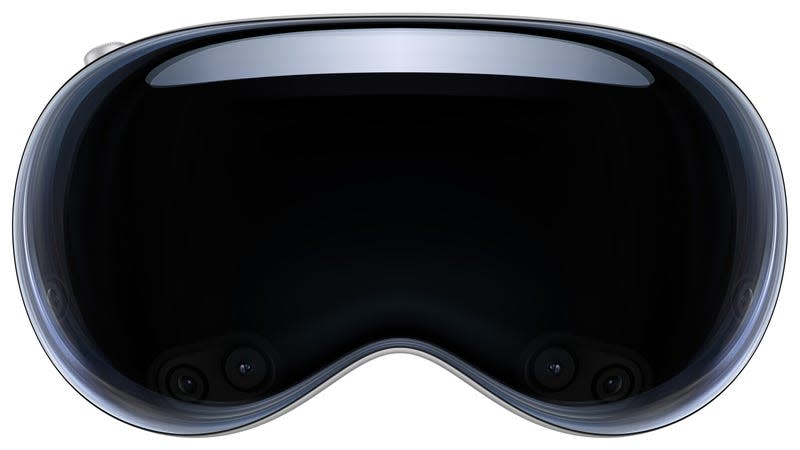Apple Reveals ‘Vision Pro’ Mixed Reality Headset at WWDC 2023

Apple revealed what could be its most consequential new piece of technology in years at WWDC Monday. The Apple “Vision Pro” headset is a slimmed-down headset device meant to facilitate both virtual reality and augmented reality.
Oh, and it’s going to cost $3,449 out the starting gate. Apple said the device should be available “early next year.”
Read more
“In the same way Mac introduced us to personal computing and iPhone introduced us to mobile computing, Vision Pro will introduce us to spatial computing,” CEO Tim Cook said.

The new headset includes several passthrough cameras on its exterior designed to allow for a full AR experience, including hand and eye tracking. The Vision Pro supposed to act like a wearable MacBook with all the apps and fixings users have come to expect. The headset is meant to operate with some of Apple’s most popular home, life, and workplace apps. This includes Messages, Books, Camera, FaceTime, Mail, Music, and Safari, as well as Microsoft productivity software like Word, Teams, and Excel.
Users control the system using gestures like pinching or flicking. Apple said hands do not need to be held in front of the camera to use. Otherwise, those in the headset need to use Siri-like voice controls to search for webpages, or just use a keyboard and mouse that should connect to the headset. Users should also be able to take a MacBook screen and make it appear in front of them.
What kind of tech powers the Vision Pro?
Apple doesn’t much like the idea of isolating technology. Users in the headset should be able to see other people walking in the foreground, while the front of the headset includes a screen that shows what users eyes are looking at, so those on the outside can track your irises as they dart around like a frog watching a fly buzz around its head.
The headset is powered by Apple’s own M2 processor as well as a new silicon called the R1 chip. Both these chips are supposed to handle both the external cameras collecting spatial information plus the invisible LED light that’s tracker users’ eyes. On the Vision Pro’s exterior, it sports several sets of sensors including side cameras, downward cameras, TrueDepth cameras, and a LiDAR scanner.
Apple’s AR team leader Mike Rockwell claimed the actual lenses show 23 million pixels across to MicroOLED screens. The lenses include three 3D lenses meant to display users content “everywhere they look.” The company didn’t discuss its precise field of view content, but the Vision Pro should support 4K video.
The new operating system powering the device is called visionOS which is supposed to allow developers an open platform for new apps.
What features will the Vision Pro have?
The headset should also facilitate movies, with promises for more 3D movies. This includes a partnership with the Walt Disney Company whose CEO Bob Iger promised more virtual experiences despite the company laying off thousands of staff earlier this year.
All the apps can appear surrounding the Vision Pro users in whatever space they’re in. You can change the depth and location where these apps appear, and you can use a dial on the outside of the headset to change your surroundings from a living room environment to a scenic outdoors setting. Vision Pro should also include spatial audio through “audio ray tracing” which is meant to map your room and understand where sounds could come from.
How long will the battery in the Vision Pro last?
All those apps have been tailored to work inside the confines of the headset’s lenses, and—of course—there will be games as well. The company promised the Vision Pro is lightweight and comfortable enough for multiple hours of use, though we’ll need some long time testing out the device to see how well it deals with the classic VR problem of eye strain.
Apple’s showcase shares that there is indeed a wired external battery meant to be worn in a user’s pocket. As far as its battery life goes, the headset can be plugged in for all-day use, but its external battery connected via a cable carries a charge that could only last about two hours. This is about the same as the Meta Quest 2 and other cheap offerings. It remains to be seen how it competes with Meta’s upcoming Quest 3 offerings. Apple reportedly had to sacrifice much of CEO Tim Cook’s original intent for the device, so what we saw at WWDC seems to be everything Apple could possibly do with the technology at hand.
More from Gizmodo
Sign up for Gizmodo's Newsletter. For the latest news, Facebook, Twitter and Instagram.

